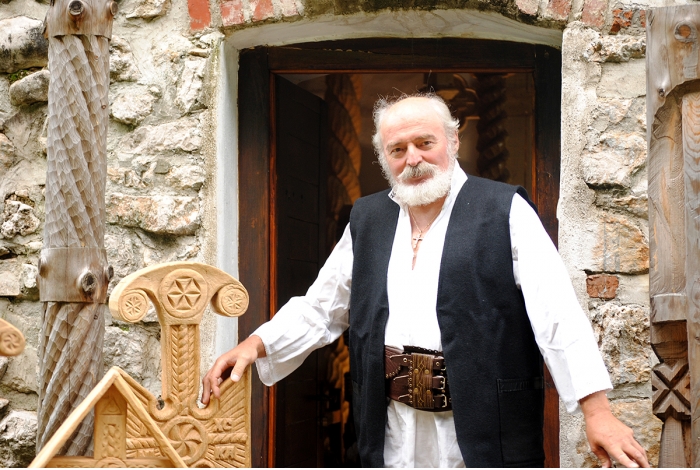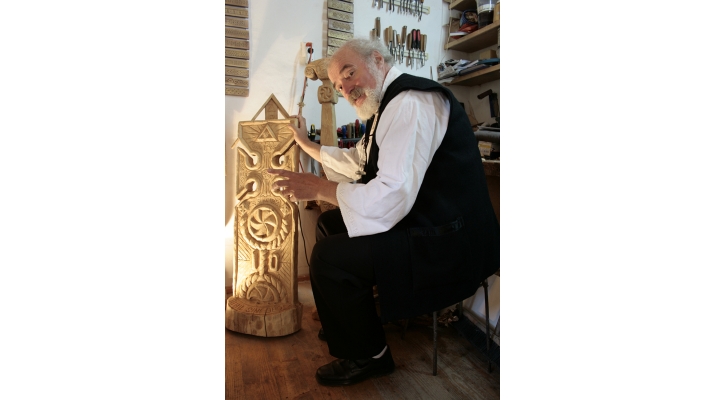“Sculpting is a personal way of seeing the beauty in life”
Ioan Croitor-Brădescu has made it his job to keep Romanian traditions alive in his sculptures and in his heart. His passion started 54 years ago, when - only 4 years old - he would go to his grandparents’ house on the Superior Valley of Mureş.

Ioan Croitor-Bradescu. Photo By Ana A. Negru
says traditional sculptor Ioan Croitor-Brădescu
His grandfather was a carpenter, and the 4-year old child was intrigued the way his grandfather worked with the wood and created new things. He loved the smell of the wood, and went out of his way to help the old sculptor. Having grown up and become a sculptor himself, he draws his inspiration for his work from nature, tradition, people, all of which form what he calls ‘the big painting of life’.
- Can you explain to us the origin of the cross and how all of the symbols started?
In Strasbourg, at a very important exhibition, I presented the theme of the cross and its ancient origins. In pastoral times, when the nomad people would travel, once they found a spot with water and grass for their animals, they would stop and place a pole or a stake in the ground to claim their land. Around this pole, they would start a community. At first, the pole was just a wooden stick. However, over time, many nomad groups were formed, and the need to customize the pole was brought up. Time passed and the nomads realized that they were living in harmony with the nature and with the universe. For them, the sky meant ‘the land of god’, and they longed to be in communion with heaven and divinity. They attempted to bring the sky closer, which meant changing the poles into columns, and calling them ‘The Shoe of the Sky’. They imagined that through this column, the sky unites with earth. The upper part of the column was thought of to be like the human head, and it represents the universe and the unknown. The column itself can be compared to a tree trunk, and the human body.
The inferior part of the column is like the tree roots or human feet, representing hell. At one point, the people came together and built a temple. In the temple, the people place two columns in the front and two columns in the back. In the center, they built a fire. They began to stabilize in a place for a long time, so they covered the columns with four walls and a roof with a hole in it for the smoke to escape, and a small door. The reason for the small door is religious- it is meant so that everyone who enters the temple must bow in a sign of respect for the divinity. Now, we are losing this sign of respect in need of comfort and modernity. Some ornamental elements of the columns were taken and placed on the cross, on the crucifix or on the porch of the house. Today, these elements are still preserved.
- What are the meanings of the symbols you use in your work?
The two crosses in the work mean ‘faith and connection with the divinity.’ The superior part of the sculpture means ‘the light, the sky, the heaven, the spiritual dimension and evolution, and the passing of time and life.’ The number ‘1’ on the sculpture means ‘man’, and the number ‘0’ on the sculpture means ‘woman’. The bottom part or inferior part of the sculpture means ‘the darkness, the hell, the roots, the feet, the inferior part of the human body, the material part and the falling’. I also use certain symbols like the eye at the superior part of the cross. This eye means ‘the eye of God’. The last symbols that I feel are very important are the initials on the cross, and they mean ‘Jesus Christ will prevail’.
- What does sculpting personally mean to you? Why do you enjoy it?
Sculpting is my way of understanding things. It is a personal way of seeing the beauty of life without forgetting for any second of the Romanian history. I feel I will always hold God close with me and I will forever cherish my values.
- You keep mentioning values; which do you appreciate the most?
Honesty, it is the most important. However, in my work, you will find a lot of values - even the ones that I learned as a child or discovered on my own. For me, it is important to remain uncontrolled by external or modern influences.
- What sorts of people mostly appreciate your carving? Is the youth also interested in sculpting?
Generally they are people who love nature because my works come from the earth. They are sensitive people who love tradition and history. There is a nearby high school, however not one student has stopped by to learn about sculpting. They are not interested. Occasionally, students will stop by to look at the sculptures, but not very often. In the North of Romania, people are more respectful of nature and tradition.
- What role would you like your sculpture work to play in modern society, and for youth?
For everything I do, I want to build something in the soul of everyone who visits me and views my sculptures. I speak to everyone about faith.
- What message do you want to convey through your work?
The message is love. Love for nature, for tradition, for God, for everything.
Text: Ashley Whitted
Photo: Ana A. Negru




